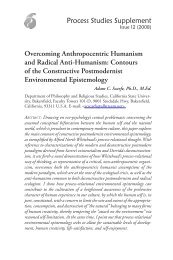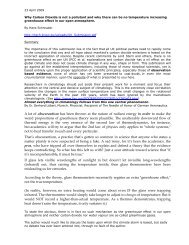Rethinking the "greenhouse effect" - Here
Rethinking the "greenhouse effect" - Here
Rethinking the "greenhouse effect" - Here
You also want an ePaper? Increase the reach of your titles
YUMPU automatically turns print PDFs into web optimized ePapers that Google loves.
<strong>Rethinking</strong> <strong>the</strong> "<strong>greenhouse</strong> effect"<br />
It is widely believed that without <strong>the</strong> <strong>greenhouse</strong> effect our planet’s<br />
near-surface temperature would be about -18° Celsius, so we have<br />
<strong>greenhouse</strong> gases to thank for an average of +15° instead. Water<br />
vapor, carbon dioxide and o<strong>the</strong>r such gases all combine to raise <strong>the</strong><br />
air’s temperature 33 degrees.<br />
But is this true? Actually, all we're going on is (1) that our atmosphere<br />
is much warmer than radiant energy calculations predict, and (2) that<br />
<strong>the</strong> air contains trace gases that react to infrared. So we have<br />
assumed that <strong>the</strong>se two things must be related.<br />
The evidence challenges that assumption, however. 1 bar being <strong>the</strong><br />
earth’s air pressure at sea level, <strong>the</strong> graph below depicts temperature<br />
changes between 0.1 and 1 bar of pressure on earth and five o<strong>the</strong>r<br />
planets. Most figures are from NASA's Planetary Fact Sheets<br />
http://nssdc.gsfc.nasa.gov/planetary/planetfact.html<br />
From 0.1 to 1 bar...<br />
Venus rises 100°C.<br />
Earth rises 68°.<br />
Jupiter rises 53°.<br />
Saturn rises 50°.<br />
Uranus rises 23°.<br />
Neptune rises 17°.<br />
Yet...<br />
Venus receives 2614 watts per square meter from <strong>the</strong> sun.<br />
Earth receives 1368 watts from <strong>the</strong> sun.<br />
Jupiter receives 50.5 watts from <strong>the</strong> sun.<br />
Saturn receives 14.9 watts from <strong>the</strong> sun.<br />
Uranus receives 3.71 watts from <strong>the</strong> sun.<br />
And Neptune receives a piddling 1.51 watts from <strong>the</strong> sun.
The solid line that you see shows <strong>the</strong> solar irradiance a planet receives<br />
measured in Watts per square meter. Notice in particular that<br />
although it collects less than 2 watts per square meter — 0.058% of<br />
what Venus enjoys — Neptune’s atmosphere at a mere one bar of<br />
pressure manages to raise <strong>the</strong> planet to 154% of <strong>the</strong> temperature that<br />
a purely radiative (blackbody) model would predict.<br />
What trait do <strong>the</strong>se planets share? Just <strong>the</strong> presence of an<br />
atmosphere dense enough to reach 1 bar of pressure. Jupiter’s<br />
enormous pressure doesn’t stop <strong>the</strong>re, of course. It continues until <strong>the</strong><br />
temperature is far higher than Earth’s - and it does this with hydrogen<br />
and helium, which are not <strong>greenhouse</strong> gases. Measurements indicate<br />
that Saturn, too, having only 15 watts to deal with compared to<br />
Earth’s 1368, falls short of Earth by only 15 degrees. Or might also<br />
surpass it.<br />
The rate of heating is an intriguing feature here. For instance, Earth<br />
climbs from 220° Kelvin to 288, making for a rate of 1.3 (288/220),<br />
while Saturn goes from 84 to 134, a rate of 1.6. A planet’s overall<br />
density appears to be a key factor, for comparing 1 bar heating rates<br />
to densities relative to Earth reveals an inverse relationship.
It seems as a general rule that <strong>the</strong> greater <strong>the</strong> ratio of gas to solid and<br />
liquid, <strong>the</strong> greater <strong>the</strong> heating rate. But it should also be pointed out<br />
that <strong>the</strong> rates for Earth and Neptune are identical. Loss of solar<br />
energy does play a role, as <strong>the</strong> falling midpoint line suggests.<br />
One last detail about <strong>the</strong> first chart. Notice that in every case <strong>the</strong><br />
temperature of a planet even at 1 earth-atmosphere is higher than<br />
a blackbody temperature prediction. The reason for this discrepancy<br />
seems obvious: A blackbody equation only calculates for radiant<br />
energy; it ignores <strong>the</strong> inherent <strong>the</strong>rmal impact of an atmosphere. How<br />
such heating is accomplished is a matter of conjecture. It's possible<br />
that gas expansion on <strong>the</strong> sunlit side of a planet and contraction on<br />
<strong>the</strong> shadow side induces a pumping effect that gets convection<br />
currents going so that cool descending air — encountering pressure —<br />
acquires a higher temperature, <strong>the</strong> result that always occurs when<br />
gases are compressed. But by whatever means atmospheric pressure<br />
due to gravity generates heat by itself, <strong>the</strong> evidence clearly indicates<br />
that it does.<br />
Alan Siddons<br />
Venus Earth Jupiter Saturn Uranus Neptune<br />
2613.9 1368 50.5 14.9 3.71 1.51 Irradiance<br />
231.7 254.3 110 81.1 58.2 46.6 Blackbody<br />
350 288 165 134 76 72 1 bar<br />
250 220 112 84 53 55 0.1 bar<br />
100 68 53 50 23 17 Delta<br />
1.40 1.31 1.47 1.60 1.43 1.31<br />
Rate<br />
rise<br />
of








